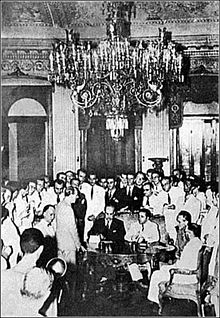Protocol of Rio de Janeiro
The Protocol of Rio de Janeiro on January 29, 1942 put the supposed end to the Peruvian-Ecuadorian War for territory in the Amazon Basin . The South American ABC states and the USA hoped that with their additional signatures to the agreement between the foreign ministers of both states they would finally settle the territorial disputes between neighboring Peru and Ecuador and resolve a decades-long conflict.
content of the contract
The disputed territory was awarded to Peru. In the future, the border between the two states should form the watershed of the rivers Río Zamora and Río Santiago . Ecuador gave up the claim to an area of about 200,000 square kilometers and also the claim to access to the Amazon. Article VI of the Protocol, on the other hand, established free shipping and trade in the disputed area of the Amazon Basin. However, this agreement did not come to fruition. The conclusion of the contract was felt by many in Ecuador as a national disgrace.
Common markings of the border came to a standstill.
Further course
In 1947, the Río Cenepa was discovered in the disputed area. The course of the river lying between the two rivers mentioned in the protocol was reason for Ecuador to demand a revision of the border agreement. It declared the implementation of the Rio Protocol impossible over a stretch of 78 kilometers. Peru closed the neighboring country's request for renegotiation and insisted on compliance with the agreement. Ecuador's President, on the other hand, announced the invalidity of the Rio de Janeiro Protocol in his country. Renewed border disputes and military skirmishes broke out again and again and finally led to the Cenepa War in 1995 .
web links
- Contract text (English translation) (PDF; 51 kB)
itemizations
- ↑ Latin America News, December 1998 Issue Number 294: The "Peace Won" , accessed July 13, 2015.
